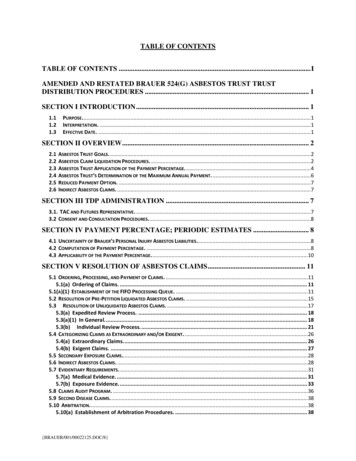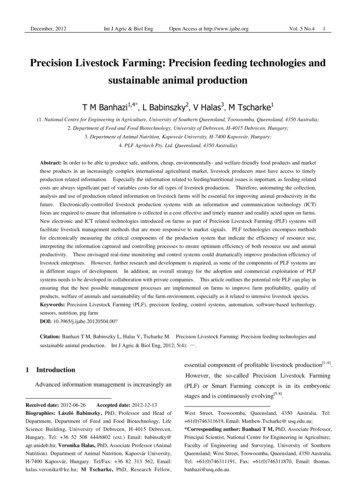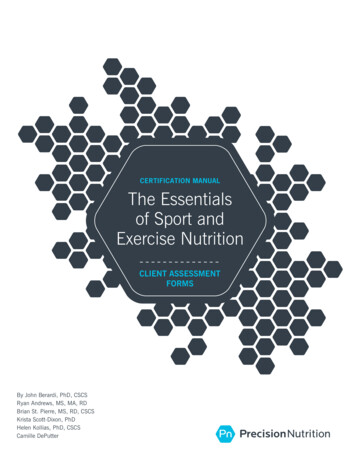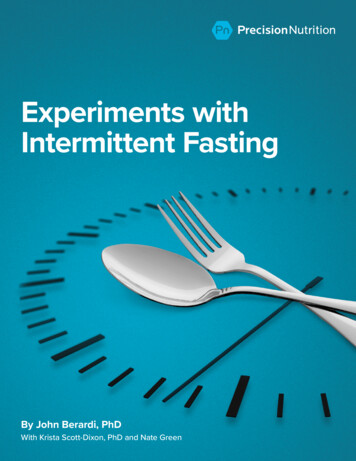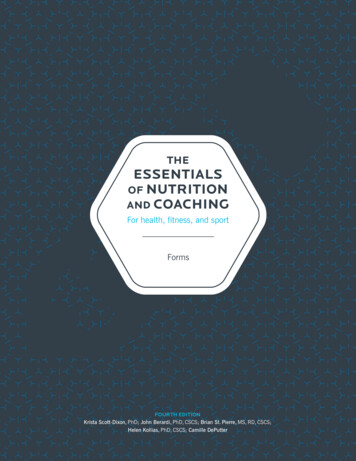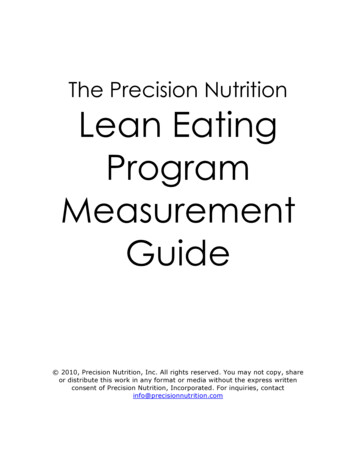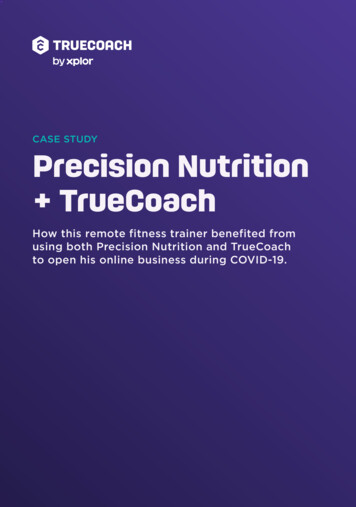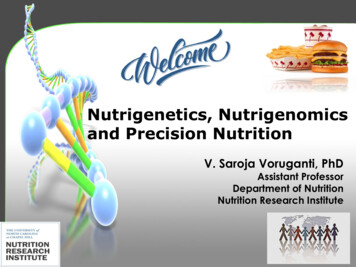
Transcription
table of contents1. the rules of good nutrition. 42. eat more protein. 93. balancing dietary acids. 124. from north american to nutritious . 165. food preparation strategies. 216. eating on the road: travel strategies. 277. revving your metabolism. 31apppendix a: what’s in my fridge. 36appendix b: what’s in my cupboard . 39about dr. john berardi . 42about precision nutrition . 43
1. the rules of good nutritionWhat are the rules of good nutrition? What exactly do you have to do to succeed– and importantly, what do you have to you avoid?Take a moment and think about it.If you want to improve the way your body looks, the way it feels, and the way itperforms – and if you want to do all three simultaneously – what guidelinesshould you follow?Come up with that list in your mind right now. Write it down if you can.Now take a look over that list and think for a moment about where you learnedthose rules.Some of the rules we live by are taught to us by our parents. Others come fromother family and friends. Some food choices are shaped by emotionalassociations (real or perceived); these are the so-called comfort foods.And of course, no one is immune to media influences. A report on the nightlynews, an article in a newspaper or glossy magazine, the commercials ontelevision. These days you can’t take a step without someone reading the riot actabout this or that ingredient or pitching you this or that new food product.Nutrition is the talk of the town. Heck, every 3rd episode of Dr. Phil is aboutfood and dieting.And, no doubt, your nutrition rules have probably been influenced by your ownpast attempts, successful or unsuccessful, at changing your body.When you list all these influences, you start to notice a few things: one, that mostof the influencing is done subconsciously, without our even knowing it; and two,that we’re being influenced by people who know little or nothing about goodnutrition.Hey, I love my friends, I love my family, and I love reading and watching TV asmuch as the next guy. But I’m very selective about whom I trust, and where I domy research – and if you care about your body, then you should be too.So let’s look at what really works. Let’s change the rules.strategies for success4
Before we begin, I’m going to level with you here: changing the rules meanschanging your habits – and it’s difficult. Not only does it take a desire to change(the “want to”) but also a strategy (the “how to”).The “want to” is all your own. But the “how to” is something I can help youwith. It’s what I do best: I’ve committed my career to helping people change theirrules and change their habits. I’ve seen first hand what works and what doesn’t,both in the lab and in the field, so I can help you skip the common pitfalls, bustthe prevailing myths, and fast-track to success.I’m not going to soft-pedal it, though. Depending on where you’re at right now,this could mean making big changes. But by making those changes to how youeat, you’ll also reap the rewards. You’ll improve your mood and sense of wellbeing, the quality of your sleep, they way you perform in day-to-day activities orduring athletic events, and of course, the way you look.To do so requires a systematic approach, one I cover in great detail in PrecisionNutrition. Here I’m going to teach you a critical part of that system, the Triple SCriterion and the 10 Rules of Good Nutrition, and if you want more help, comecheck us out at precisionnutrition.com. Make no mistake, though: even just byapplying the principles outlined in this chapter alone, you’ll be ahead of nearly99% of all recreational exercisers and elite athletes – never mind the generalpopulation.the triple s criterionWhat’s the Triple S Criterion? Well, it represents a three-step way of evaluating astrategy for its usefulness.Step 1: Simplicity.Are the rules easy to follow?Step 2: Science.Are the rules based on sound scientific principles?Step 3: Success.Have the rules actually worked for people like you?No matter what nutritional information you’re given, you’ve got to apply thatthree part test. If the answer to each question isn’t a resounding “YES,” youmight as well toss the info out the window.strategies for success5
Think again about those nutritional rules you came up earlier, the things thathave influenced your thinking. Would they pass the test? Are those rules basedon simplicity, science, and success? And importantly, have they produced thedesired effect, a lean, healthy body that you’re able to maintain easily? Havethose rules built a body that you’re happy with when looking in the mirror?If not, perhaps they could use a re-evaluation.the 10 rules of good nutritionBelow, I’d like to present my 10 Rules of Good Nutrition, rules based on theTriple S Criterion above. In doing so, I hope to accomplish 2 goals.First, I want to help you rethink your whole nutrition approach and provide youwith a new set of nutrition rules and habits, a set that swiftly moves you in thedirection of your goals.Secondly, I want to show specifically how the strategies laid out in this bookoffer much more than a few ideas – they represent a complete success system,fully integrated into the basic habits of good nutrition.So here are the 10 rules:1. Eat every 2-3 hours.Are you doing this – no matter what? Now, you don’t need to eat a full mealevery 2-3 hours but you do need to eat 6-8 meals and snacks that conform to theother rules below.2. Eat complete, lean protein each time you eat.Are you eating something that was an animal or comes from an animal – everytime you feed yourself? If not, make the change. Note: If you’re a vegetarian, thisrule still applies – you need complete protein and need to find non-animalsources.3. Eat vegetables every time you eat.That’s right, in addition to a complete, lean protein source, you need to eat somevegetables every time you eat (every 2-3 hours, right?). You can toss in a piece offruit here and there as well. But don’t skip the veggies.4. Eat carbs only when you deserve to.strategies for success6
Well, not ALL carbs – eat fruits and veggies whenever you want. And if want toeat a carbohydrate that’s not a fruit or a vegetable (this includes things likesimple sugars, rice, pasta, potatoes, bread, etc), you can – but you’ll need to saveit until after you’ve exercised. Yes, these often heavily processed grains aredietary staples in North America, but heart disease, diabetes and cancer aremedical staples – and there’s a relationship between the two! To stop headingdown the heart disease highway, reward yourself for a good workout with agood carbohydrate meal right after (your body best tolerates these carbohydratesafter exercise). For the rest of the day, eat your lean protein and a deliciousselection of fruits and veggies.5. Learn to love healthy fats.There are 3 types of fat – saturated, monounsaturated, and polyunsaturated.Forget about that old “eating fat makes you fat” maxim. Eating all three kinds offat in a healthy balance (about equal parts of each) can dramatically improveyour health, and even help you lose fat. Your saturated fat should come fromyour animal products and you can even toss in some butter or coconut oil forcooking. Your monounsaturated fat should come from mixed nuts, olives, andolive oil. And your polyunsaturated fat should from flaxseed oil, fish oil, andmixed nuts.6. Ditch the calorie containing drinks (including fruit juice).In fact, all of your drinks should come from non-calorie containing beverages.Fruit juice, alcoholic drinks, and sodas – these are all to be removed from yourdaily fare. Your best choices are water and green tea.7. Focus on whole foods.Most of your dietary intake should come from whole foods. There are a fewtimes where supplement drinks and shakes are useful. But most of the time,you’ll do best with whole, largely unprocessed foods.8. Have 10% foods.I know you cringed at a few of the rules above. But here’s the thing: 100%nutritional discipline is never required for optimal progress. The difference, inresults, between 90% adherence to your nutrition program and 100% adherenceis negligible. So you can allow yourself “10% foods” – foods that break rules, butwhich you’ll allow yourself to eat (or drink, if it’s a beverage) 10% of the time.Just make sure you do the math and determine what 10% of the time reallymeans. For example, if you’re eating 6 meals per day for 7 days of the week –that’s 42 meals. 10% of 42 is about 4. Therefore you’re allowed to “break therules” on about 4 meals each week.strategies for success7
9. Develop food preparation strategies.The hardest part about eating well is making sure you can follow the 8 rulesabove consistently. And this is where preparation comes in. You might knowwhat to eat, but if isn’t available, you’ll blow it when it’s time for a meal.10. Balance daily food choices with healthy variety.Let’s face it, when you’re busy during the week, you’re not going to be spendinga ton of time whipping up gourmet meals. During these times you’re going toneed a set of tasty, easy to make foods that you can eat day in and day out.However, once every day or a few times a week, you need to eat somethingdifferent, something unique and tasty to stave off boredom and stagnation.what about everything else?So what about caloric intake, or macronutrient ratios, or all the other technicaland theoretical issues that are often debated? The short answer is that thosethings only become relevant once you’re practicing the above-mentioned habits,and by practicing them I mean putting them to use over 90% of the time (i.e., nomore than 4 meals out of an average 42 meals per week violate any of thoserules).Moreover, most people can achieve the health and the body composition theydesire just by following those ten rules alone. No kidding! In fact, with someclients I’ve spent months just supervising their adherence to those rules. That’san effective but costly way to learn them. If you can do it on your own, you’llsave money and a ton of wasted time.Now obviously, everyone needs some individualization beyond the habits. Forthat, check out Precision Nutrition.But before assuming you’re ready for individualization, make sure you’ve trulymastered the habits. Then, while keeping the habits as the consistent foundation,tweak away.strategies for success8
2. eat more proteinNowadays there are a lot of misconceptions with respect to protein intake.Should one take in 1 gram of protein per lb of body weight? Or is it 1 gram perkilogram? And, to the non-scientist, just how much is that?Well, before discussing this issue, I think it’s important to explore the differencebetween protein need and protein optimization. When someone asks, “Howmuch protein should I eat?” they’re usually trying to figure out how muchprotein they need to optimize body composition and performance. But thequestion, "How much protein does an athlete need?" is a very different one from"How much protein should an athlete consume to improve body compositionand athletic performance?"In the research world, the word “need” is in no way associated withoptimization. Instead it's defined as the minimum amount necessary in order toprevent deficiency. Therefore, in asking how much protein an athlete needs,you're asking the question "What's the minimum amount of protein an athletecan get away with to prevent wasting and eventual death?"Since most athletes have access to and usually consume enough protein to staveoff death, the common protein question about how much protein an athlete needsis a bad one. The important question is really, “How much protein should anathlete consume to improve performance and body composition?”So, how much protein do individuals need to optimize performance and bodycomposition? Well, the truth is that no one knows exactly. Why? Because everyindividual is different.However, what I do know is this – about 85% of all the individuals I’ve everconsulted with have been eating less protein than I recommend. And the firstthing I do to stimulate results (and usually “results” mean body compositionchanges) is to increase the protein intake while making a few concomitantchanges to carbs and fat intake.Now, there are a number of reasons why I boost protein intake in most clients soI’d like to outline them in this article.strategies for success9
Reason #1: Increased Thermic Effect of Feeding.While all macronutrients require metabolic processing for digestion, absorption,and storage or oxidation, the thermic effect of protein is significantly higher thanthat of carbohydrates and fat. In fact, protein requires 25-30% of the energy itprovides just for digestion, absorption, and assimilation while carbs only require6-8% and fat requires 2-3%. That means that eating protein is actuallythermogenic and can lead to a higher metabolic rate. This means greater fat losswhen dieting and less fat gain during hypercaloric diets.Reason #2: Increased Glucagon.Protein consumption increases plasma concentrations of the hormone glucagon.Glucagon is responsible for antagonizing the effects of insulin in adipose tissue,leading to greater fat mobilization. In addition, glucagon also decreases theamounts and activities of the enzymes responsible for making and storing fat inadipose and liver cells. Again, this leads to greater fat loss during dieting andless fat gain during overfeeding.Reason #3: Increased IGF-1.Protein and amino-acid supplementation has been shown to increase the IGF-1response to both exercise and feeding. Since IGF-1 is an anabolic hormone that'srelated to muscle growth, another advantage associated with consuming moreprotein is more muscle
with a new set of nutrition rules and habits, a set that swiftly moves you in the direction of your goals. Secondly, I want to show specifically how the strategies laid out in this book offer much more than a few ideas – they represent a complete success system, fully integrated into the basic habits of good nutrition. So here are the 10 rules: 1. Eat every 2-3 hours.
